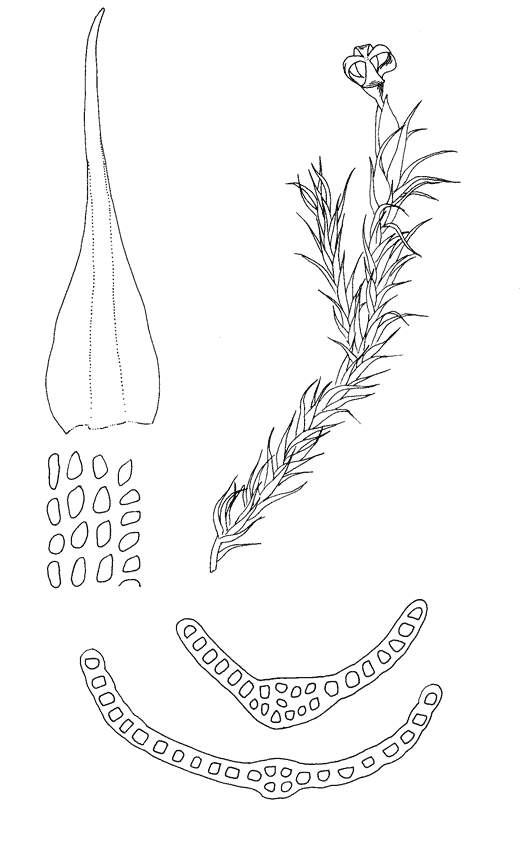- Map Distribution
- Description
- eFlora Distribution
- Illustrations
- Cal Photos images
- Elevation by latitude plot
MAP CONTROLS
1. You can change the display of the base map and layers by clicking on the layer control box in the upper right-hand corner.
2. California county polygons can be turned off and on in the layer control box.
3. Filling of Jepson subdivision polygons can be turned off and on in the layer control box.
Database links
UC Specimens in the University and Jepson Herbaria Public Portal
Specimens of Andreaea blyttii in the Consortium of North American Bryophyte Herbaria portal (CNABH)
Andreaea blyttii
Plants in dense turfs, to 15 mm high, almost unbranched, red-brown in younger portions but black in older portions. Stems dark red to black even in young material. Lower portion of stem clothed with closely appressed scale like leaves which are deeply concave in their proximal 2/3. Upper leaves, when dry, loosely appressed when dry, erect spreading from a somewhat sheathing base when moist. Leaves to 1.2 mm long, about 4: 1, narrowly lanceolate, acuminate to the narrow subula, somewhat concave below. Median cells smooth throughout, arranged in very regular rows, to 10 µm wide, isodiametric and rounded with strongly trigonous thickenings, incrassate with lumen/wall ratio about 1: 1. Marginal cells of leaf isodiametric or short rectangular but not ver different from the interior ones. Cells of median leaf base to 8 µm wide, with thick (lumen: wall ratio 1: 1) and pitted walls, 6–8: 1 with straight lateral walls. Costa excurrent in a subula which comprises up to 1/4 of leaf length, round in cross-section in subula but flattened and less conspicuous near base. Margins ascending and entire throughout, not at all decurrent. Stem nearly homogeneous, without a central strand, of thick-walled cells with large cells (to 12 µm in diameter). Axillary hairs to 60 µm long, 2-celled, not offset, one isodiametric and pale brown, the other elongate and clavate, very thick-walled with lumen wall ratio about 1: 1. Gemmae never present.
Dioicous. Perichaetial leaves much larger and elliptic ovate with costa abruptly excurrent in a short mucro, to 1.6 mm long, loosely sheathing the base of the pseudopodium. Pseudopodia to 3 mm long, straight. Capsule dark brown except for a pale apex, elliptic, 1.2–1.5: 1, almost globose before dehiscence, opening by four longitudinal slits. Median exothecial cells to 18 µm wide, 2–5: 1, with thick and sparingly pitted lateral walls but thin transverse walls. Exothecial cells along lines of eventual capsule dehiscence only a little more elongate narrow and thin-walled in a single row. Exothecial cells at capsule apex little differentiated. Stomates absent. Spores to 20 µm, smooth, with trilete mark.
Vouchers: Siskiyou Co.: about 1 mile west of Elk Lick, Klamath National Forest, Norris 23231 and McCloud River about 5 miles east of McCloud, Shasta-Trinity National Forest, Norris & Hillyard 103916; Tehama Co.: Mill Creek about 0.5 mile beyond Mill Creek Campground, Norris 55915.
Literature: Jessup 2000; Koch 1950a; Lawton 1971.
Geographic subdivisions for Andreaea blyttii: CaR, NW. |
Illustration References: Lawton 1971; Murray 1988.

No expert verified images found for Andreaea blyttii. |




